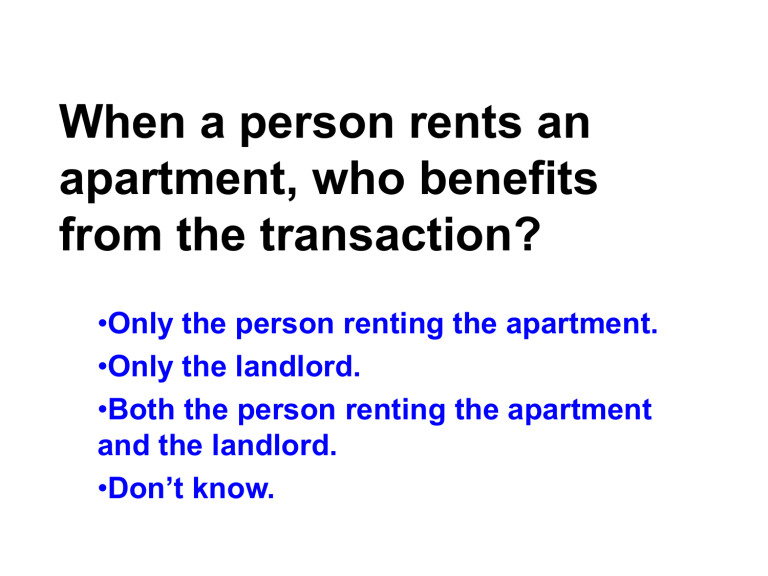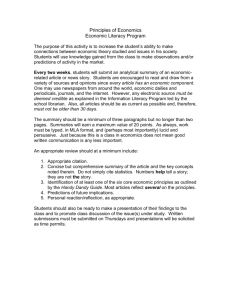When a person rents an apartment, who benefits from the transaction?

When a person rents an apartment, who benefits from the transaction?
• Only the person renting the apartment.
• Only the landlord.
• Both the person renting the apartment and the landlord.
• Don’t know.
If the price of beef doubled and the price of poultry stayed the same, people would most likely buy
• More poultry and less beef.
• Less poultry and more beef.
• The same amount of poultry and beef.
• Don’t know.
The resources used in the production of goods and services are limited, so society must
• Make choices about how to use resources.
• Try to obtain additional resources.
• Reduce their use of resources.
• Don’t know.
National Results of Test
Grade
A
B
C
D
F
Students
3%
7%
11%
13%
66%
Source: Parade, April 18, 1999
Adults
6%
10%
15%
20%
49%
The Importance of Economic Literacy
• Gary Stern (President: Federal Reserve Bank of
Minneapolis), “I am convinced that … the invisible hand works better when participants in the economy and its myriad of markets – when consumers, business people, elected officials, investors, policymakers, and so on – when they are economically and financially literate. Going one step further, the economy performs better when its participants are well-informed because well-informed participants make decisions that enhance resource allocation, and thus contribute to rising efficiency, productivity, and living standards.”
The Importance of Economic Literacy
• Robert Duvall (President and Chief
Executive Officer, National Council of
Economic Education), “Educating young people in economics and personal finance is vital to our nation’s future. Indeed, it is a key to building a nation of knowledgeable investors and savers, informed consumers, productive members of the workforce, responsible citizens, and effective participants in the global economy.”
Improving Economic Literacy:
The Role of Concurrent Enrollment Programs
Donald H. Dutkowsky
Professor of Economics
Syracuse University
Jerry M. Evensky
Associate Professor of Economics and
Laura and Douglas Meredith Professor of Teaching Excellence
Syracuse University
Gerald S. Edmonds
Director
Syracuse University Project Advance®
CEPs and Economic Literacy
• Quality college introductory courses offered to high school seniors, such as
Concurrent Enrollment Programs
(CEPs), serve as an excellent way to develop long-lasting tools for economic literacy.
• These courses work, and yet only a small percentage of the student population enrolls in such courses.
Among CEPs, AP, and IB, CEPs offer the greatest potential for reaching a broader population of high school students, and thus to expand economic literacy.
• By offering a college/high school partnership model that melds the content expertise of college faculty with the pedagogical expertise of high school teachers, CEPs empower teachers to offer high quality college introductory Economics courses to a considerably broader population of students.
The Test of Economic Literacy (TEL)
• Authors: William Walstad and Ken Rebeck.
• Published under National Council of
Economic Education (third edition).
• Widely accepted nationally normed test of economic literacy for high school students.
• Norming results published for average percentage correct for four groups.
AP/Honors Economics
AP/Honors Social Studies
Basic Economics
Basic Social Studies
Table 1 – Percentage Correct on the TEL
---------------------------------------------------------------------------------------------------
AP/Honors AP/Honors
Course/Item CEP Economics Social Studies
---------------------------------------------------------------------------------------------------
All Items (68) 75.6
74.9
57.9
By Subject Area
Fundamentals (25)
Microeconomics (15)
Macroeconomics (17)
International (11)
80.4
74.0
73.1
70.7
78.9
74.6
72.9
69.0
59.0
60.9
55.3
55.3
By Cognitive Level
Knowledge (11)
Comprehension (21)
Application (36)
81.4
77.1
73.0
77.0
77.4
72.7
64.5
57.9
55.9
---------------------------------------------------------------------------------------------------
----------------------------------------------------------------------------------------------------------------------------------------
Subject Area
AP/Honors AP/Honors
CEP Economics Social Studies
--------------------------------------------------------------------------------------------------------------------------------------------------------------
Fundamentals
Scarcity (6)
Opportunity Costs/Tradeoffs (4)
Productivity (3)
Economic Systems (4)
83.8
76.3
82.3
78.3
83.1
83.5 56.2
74.6 44.9
78.7 64.0
80.5 62.5
78.1 65.7
Economic Institutions and Incentives (5)
Exchange, Money, and
Interdependence (3)
Microeconomics
75.7
74.6 63.5
75.6
79.7
84.9
76.0 46.4
79.1 68.6
78.3 73.4
Markets and Prices (1)
Supply and Demand (6)
Competition and
Market Structure (2)
Income Distribution (2)
Market Failures (3)
Role of Government (1)
Macroeconomics
Gross Domestic Product (1)
Aggregate Supply
63.9
66.4
59.4
72.1
79.7
69.7 53.6
67.7 50.4
70.4 50.6
70.4 57.4
74.5 54.3
And Demand (4)
Unemployment (2)
Inflation and Deflation (4)
Monetary Policy (3)
Fiscal Policy (3)
International
Comparative Advantage/
Barriers to Trade (5)
79.9
73.9
49.0
83.0
73.5
81.1 68.9
75.2 59.7
56.5 29.9
79.5 66.3
74.7 56.4
Balance of Payments and
Exchange Rates (4)
International Growth
And Stability (2)
66.6
72.0
60.7 50.4
71.3 62.2
--------------------------------------------------------------------------------------------------------------------------------------------------------------
Table 3 – Number of Questions With Significantly Different
Average Performance: CEP Versus AP/Honors
--------------------------------------------------------------------------------------------------------
AP/Honors Economics AP/Honors SS
---------------------------------------------------------------------
Item CEP Better CEP Worse CEP Better CEP Worse
--------------------------------------------------------------------------------------------------------
All Items (68) 15 7 52 0
By Subject Area
Fundamentals (25)
Microeconomics (15)
8
2
Macroeconomics (17) 2
International (11) 3
2
2
2
1
18
12
15
7
0
0
0
0
By Cognitive Level
Knowledge (11) 4
Comprehension (21)
Application (36)
2
9
0
2
5
10
17
25
0
0
0
---------------------------------------------------------------------------------------------------------
CEPs and Economic Literacy:
One More Aspect
• CEPs may also offer positive spillover effects toward the teaching of the basic high school Economics course, or infusing Economics in Social Studies courses.
Table 4 – Percentage Correct on the TEL: Non-AP/Honors
-----------------------------------------------------------------------------------------------
Course/Item Economics Social Studies
-----------------------------------------------------------------------------------------------
All Items (69) 61.3
41.4
By Subject Area
Fundamentals (25)
Microeconomics (15)
Macroeconomics (17)
International (11)
67.0
62.3
57.0
53.4
42.1
45.4
37.9
39.6
-----------------------------------------------------------------------------------------------
Source: Walstad and Rebek (2002).





